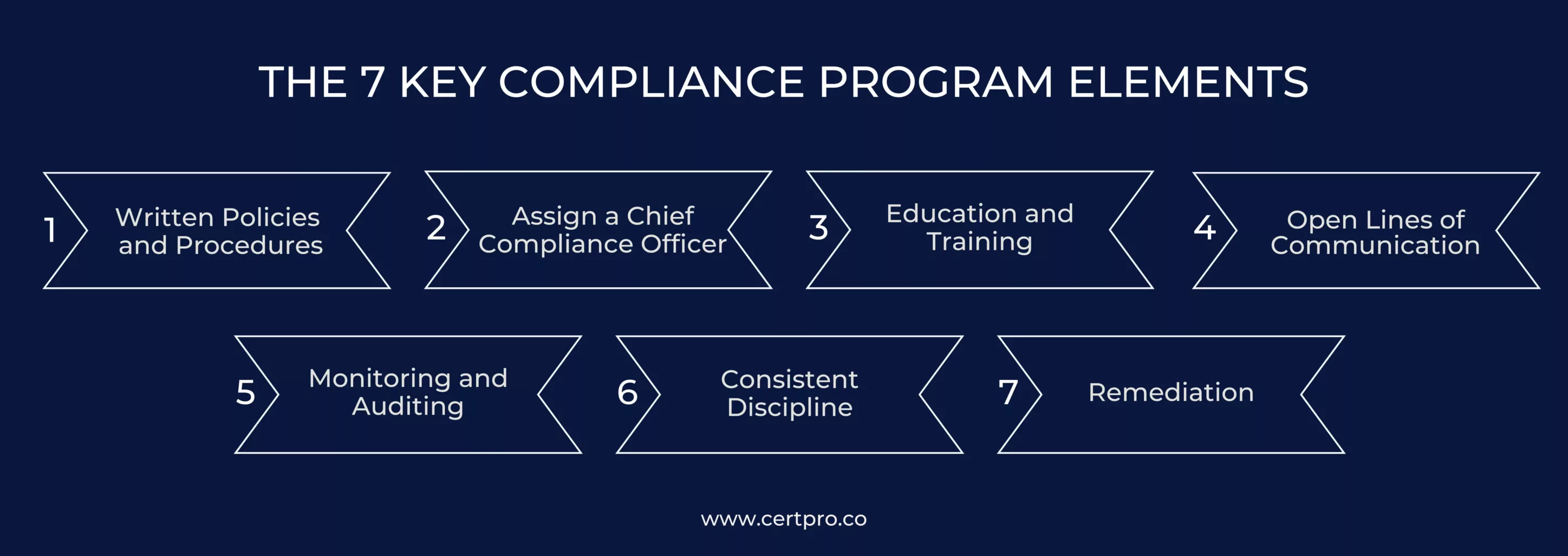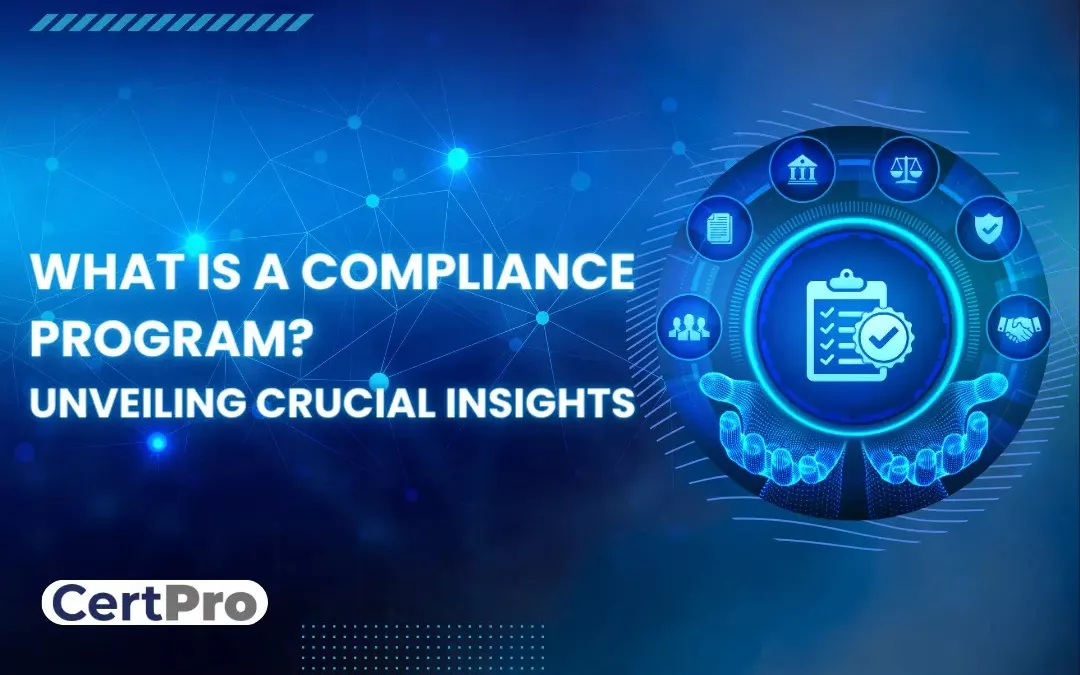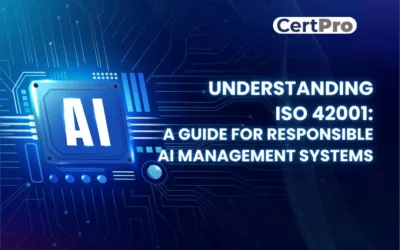Organizations face many different obstacles in the fast-paced, constantly evolving world of modern business. These challenges include strict legal requirements, high ethical standards, and elevated expectations when it comes to corporate governance. Considering this complex environment, many businesses proactively implement compliance programs as a way to manage the complications. However, the fundamental question still stands: What is a compliance program exactly, and why has it evolved into a crucial component of contemporary business operations?
A compliance program is a methodical framework that is carefully crafted to guarantee that businesses and the people who work for them follow the various legal requirements, moral standards, and corporate governance guidelines that are pertinent to their business and methods of operation. By serving as a compass and directing businesses through the complex web of moral and legal issues, this all-encompassing strategy fosters accountability, honesty, and openness.
The awareness that the business environment is not only complex but also evolving is what drives the implementation of compliance programs. As firms attempt to survive in the face of these obstacles, compliance programs serve as a strategic response to cultivate an ethical culture and effectively negotiate the intricacies of regulatory landscapes. A compliance program is essentially an organization’s commitment to ethical and legal business practices. It includes a wide range of guidelines, protocols, and practices that, when taken as a whole, provide a strong barrier against possible legal traps, moral failings, and governance deficiencies. We will examine compliance program elements, advantages, and importance in greater detail as we peel back the curtain on this crucial facet of contemporary business administration. Come along as we explore the world of compliance and highlight the insights that highlight how crucial it is to maintaining morally sound, legally compliant, and resilient enterprises.
WHAT IS A COMPLIANCE PROGRAM?
An essential component of corporate governance, a compliance program consists of an organization’s internal policies and procedures that are carefully planned to comply with laws, rules, and regulations while also preserving the company’s good name. Under the direction of a committed compliance team, this project entails a careful analysis of regulations established by the government, which results in the creation, execution, and strict observance of the compliance program throughout the entire organization.
The most important lessons emphasize how the compliance program ensures that staff members follow relevant rules and regulations by offering a framework of standards and best practices. In addition to ensuring legal compliance, these programs protect a company’s reputation by protecting it from possible scandals and negative publicity. Transparent policies, good lines of communication between staff and program supervisors, and a readiness to act to address infractions are characteristics of a strong compliance program. To put it simply, compliance programs act as watchful defenders of a business’s moral character and legal integrity.
THE 7 KEY COMPLIANCE PROGRAM ELEMENTS
According to the US Sentencing Guidelines, there are seven basic components that must be present for compliance program elements to be effective. For the purpose of preventing and identifying wrongdoing, these elements provide companies with a framework for the establishment and upkeep of strong systems.
1. Written Policies and Procedures: A well-defined policy and expectations are a vital first step in establishing an effective compliance program. Incorporating regular changes, conducting comprehensive policy reviews, and making the written program widely accessible to all employees is crucial. Including the program in the onboarding process is also essential; new hires should be required to become acquainted with it within the first ninety days. This all-encompassing strategy improves the program’s overall effectiveness while also promoting a compliance-oriented culture. Organizations can reinforce the cornerstone of their compliance activities by emphasizing accessibility, frequent updates, and prompt orientation for new team members.
2. Assign a Chief Compliance Officer: Selecting a compliance officer or committee to oversee the program’s execution is an essential next step after setting clear expectations. This person or group ought to have a strong foundation in and a deep comprehension of moral behavior. It is recommended that the selected staff report directly to the CEO, depending on the organizational structure of the company. By ensuring a direct channel of communication, this strategic posture highlights the importance of compliance within the organizational hierarchy. Companies can reaffirm their dedication to maintaining standards and skillfully negotiating the complexity of compliance by assigning the monitoring to people with a track record of ethical experience.
3. Education and Training: It takes time and money to set up a strong compliance program at work so that all staff members are knowledgeable about the most recent requirements of the program and have received the necessary training. This entails regularly checking in with current employees in addition to training new personnel.
It is imperative to hold yearly or quarterly meetings for the entire organization to discuss any issues or upgrades pertaining to the compliance program. It’s also imperative to make sure that, throughout their first few months of work, new hires receive compliance training. By encouraging a culture of awareness and adherence among all employees, these proactive tactics help the compliance program continue to succeed over time and ultimately promote a safe and moral workplace.
4. Open Lines of Communication: A compliance program’s success depends on fostering an atmosphere in which staff members at all levels feel free to express any queries or worries they may have. Establishing avenues via which staff members can anonymously report transgressions and discuss ethical concerns is critical. Compliance officers should also actively seek to be reachable and approachable in order to respond to particular questions about the compliance program.
For timely reporting and breach prevention, a strong communication channel between the people in charge of the compliance program and the workers it covers must be established. This candid discussion promotes openness and trust, developing a climate in which staff members are comfortable voicing issues and, eventually, enhancing the compliance framework’s overall efficacy.
5. Monitoring and Auditing: Implementing an auditing and monitoring system is critical for evaluating the performance of the compliance program, ensuring alignment with external regulations, and identifying potential compliance concerns. While regular internal evaluations are essential for day-to-day operations, formal external audits are also required. It is suggested that audits be conducted at least once a year, with auditors providing written reports explaining their findings.
These audits act as essential milestones, providing information about the program’s strengths and areas for development. They certify conformance to established norms and laws, providing stakeholders with reassurance. Furthermore, external audits provide an unbiased assessment, increasing trust and openness. By accepting both internal and external audits, firms may develop a healthy compliance culture, proactively addressing risks and maintaining
6. Consistent Discipline: The enforcement of a compliance program is a crucial element in its success. It is essential to have written, explicit policies that specify the consequences of noncompliance. These actions ought to be taken in cases like not meeting program requirements, failing to disclose incidents of non-compliance, and being careless in identifying non-compliance in spite of clear indicators.
The implementation of disciplinary measures is easier to handle when the program includes clear expectations and an open-door policy. Establishing accountability through clear standards and encouraging employees to voice concerns and report infractions without fear of retaliation are two different aspects of an open-door policy. Organizations can maintain compliance standards, discourage misconduct, and promote an ethical and responsible work culture by routinely enforcing disciplinary procedures in line with existing regulations.
7. Remediation: When the previous procedures are finished and a significant compliance risk or vulnerability is found—during an audit, as a result of a breach, or through internal review—the compliance committee must take swift action. It is imperative to act quickly to reduce the likelihood of non-compliance.
In order to identify the underlying reasons for the problem and create a workable solution, the committee should conduct a comprehensive investigation. This could entail putting corrective measures in place, updating rules or guidelines, offering more training, or adjusting the structure as needed. By responding to compliance issues promptly and firmly, the committee shows that it is dedicated to maintaining legal requirements and protecting the company from potential threats.

WHAT IS THE COMPLIANCE PROGRAM’S PURPOSE?
A compliance program’s purpose is to ensure that a business operates within the legal and regulatory framework that governs its industry. These programs are intended to recognize, evaluate, and reduce the risks of non-compliance, which includes breaking internal policies, laws, and regulations. Organizations seek to protect their brand, stay out of trouble with the law, preserve confidence with stakeholders, and enforce ethical standards by putting in place a compliance program. Furthermore, compliance initiatives support responsibility, openness, and an integrity-driven culture within the company. These usually entail creating guidelines and protocols, carrying out routine evaluations and audits, offering instruction and training, and applying sanctions as required. All things considered, the main objective of a compliance program is to promote a culture of compliance and guarantee that the company’s operations are compliant with relevant legal requirements, rules, and moral principles.
BENEFITS OF A COMPLIANCE PROGRAM
There are many advantages to putting in place a compliance program, such as:
1. Reducing Fraud and Abuse: A strong compliance program protects against monetary losses and legal ramifications by assisting in the detection and prevention of fraudulent activity.
2. Enhancing Healthcare Provider Operations: Compliance programs simplify operations, boost productivity, and lessen administrative overhead by encouraging adherence to rules and best practices.
3. Improving the Quality of Healthcare Services: Compliance programs ensure that healthcare providers maintain high standards of care, leading to improved patient outcomes and satisfaction.
An effective compliance program has an impact on patients, hospital administration, doctors, and the healthcare sector overall. It’s critical to automate and streamline compliance policies and procedures because major changes to the healthcare sector are anticipated.
FAQ
How often should a compliance program be updated to remain effective?
Compliance programs should be regularly reviewed and updated to stay aligned with changing regulations, industry standards, and internal needs. Typically, annual reviews are recommended, but more frequent updates may be necessary depending on the pace of regulatory changes and organizational developments.
What steps can organizations take to ensure employee buy-in and engagement with the compliance program?
Organizations can foster employee buy-in by clearly communicating the importance of compliance, providing regular training and education, involving employees in the development of policies and procedures, and recognizing and rewarding compliance efforts.
How can a compliance program accommodate the diverse needs of different departments or business units within an organization?
A compliance program can be tailored to the specific requirements of different departments or business units by conducting risk assessments, involving representatives from each department in program development, providing customized training, and implementing flexible policies and procedures where appropriate.
What are the consequences of non-compliance with a compliance program?
Non-compliance with a compliance program can result in legal penalties, financial losses, damage to reputation, loss of customer trust, and even criminal charges for severe violations. Additionally, employees found to be in violation of compliance policies may face disciplinary action, including termination of employment.
How can organizations measure the effectiveness of their compliance program?
Organizations can measure the effectiveness of their compliance program through various metrics, such as the number of compliance-related incidents, the frequency of employee training and awareness programs, the results of internal audits and external assessments, and feedback from employees and stakeholders.

About the Author
NICOLENE KRUGER
Nicolene Kruger, Regional Manager in South Africa, is an experienced Legal Counsel with expertise in compliance and auditing. Her strategic, solution-driven approach aligns legal standards with business objectives, ensuring seamless adherence to regulations.
HOW DOES THE NIST CYBERSECURITY FRAMEWORK FUNCTION, AND WHY IS IT IMPORTANT?
Emerging cyber threats make cybersecurity an essential consideration for organizations handling and managing data. In this regard, the NIST cybersecurity framework applies to improving your cybersecurity program. It is a set of guidelines that helps improve your...
UNDERSTANDING ISO 42001: A GUIDE FOR RESPONSIBLE AI MANAGEMENT SYSTEMS
The invention of artificial intelligence (AI) has changed the operational processes of many industries. However, the rapid growth of technology increases ethical, security, and privacy-related concerns. Therefore, the International Organization for Standardization...
EUROPEAN UNION’S ARTIFICIAL INTELLIGENCE ACT: HOW THIS GROUNDBREAKING LAW AFFECTS YOUR BUSINESS
Nowadays, Artificial Intelligence (AI) is transforming our lives exceptionally well. AI is now streamlining healthcare services, providing virtual assistance, and fulfilling queries. Technologies have boons and curses. Similarly, AI creates many concerns about...




